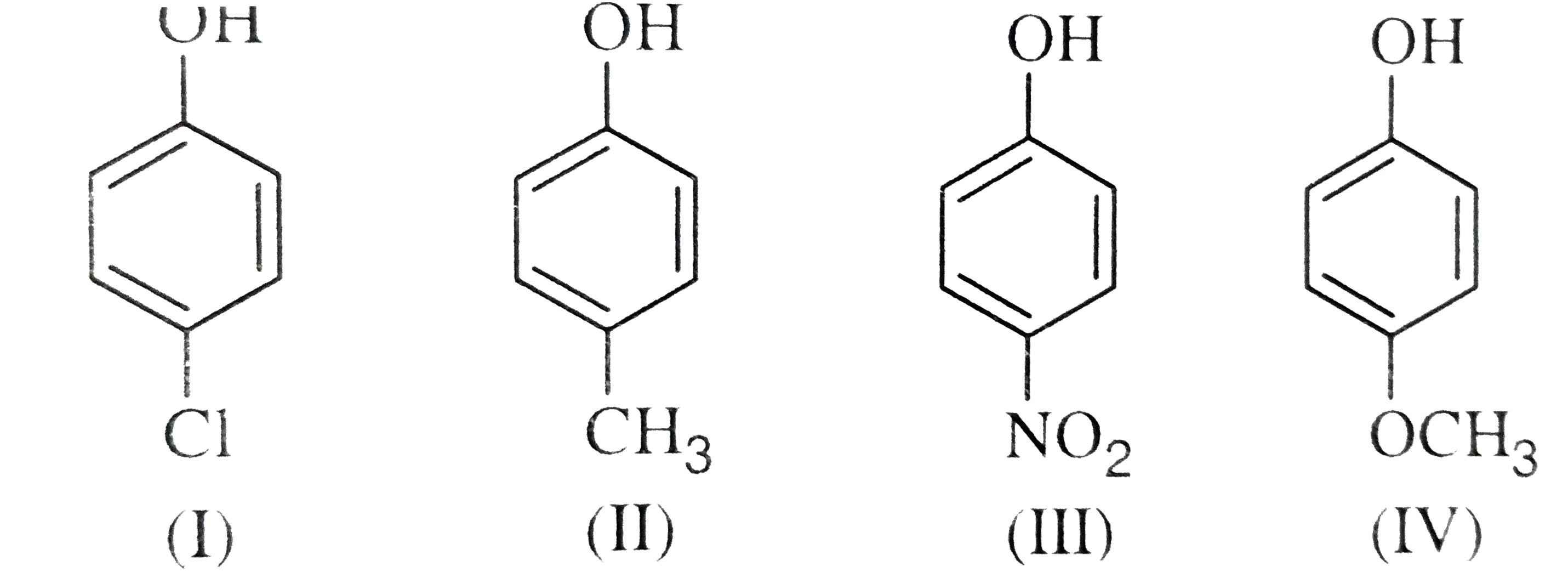Arrange the following compounds in decreasing order of acidity.
H2O,ROH,HC≡CH
To arrange the compounds H2O, ROH, and HC≡CH in decreasing order of acidity, we need to analyze the stability of their conjugate bases formed upon the release of a proton (H+).
1. Identify the Compounds and Their Conjugate Bases:
- For H2O (water), when it donates a proton, it forms OH− (hydroxide ion).
- For ROH (an alcohol), when it donates a proton, it forms RO− (alkoxide ion).
- For HC≡CH (ethyne), when it donates a proton, it forms HC≡C− (acetylide ion).
2. Stability of Conjugate Bases:
- The acidity of a compound is related to the stability of its conjugate base. The more stable the conjugate base, the stronger the acid.
- Conjugate Base of Water: OH− is relatively stable as oxygen is highly electronegative and can stabilize the negative charge effectively.
- Conjugate Base of Alcohol: RO− is less stable than OH− because the alkoxide ion has a negative charge on oxygen, but the presence of the alkyl group R can donate electron density, which destabilizes the negative charge.
- Conjugate Base of Ethyne: HC≡C− is the least stable because the negative charge is on carbon, which is less electronegative than oxygen and does not stabilize the negative charge as effectively.
3. Comparing Acidity:
- Since OH− is the most stable conjugate base, H2O is the strongest acid.
- Next, RO− is less stable than OH−, making ROH a weaker acid than H2O.
- Finally, HC≡C− is the least stable, making HC≡CH the weakest acid among the three.
4. Final Arrangement:
- Therefore, the order of acidity from strongest to weakest is:
H2O>ROH>HC≡CH
Final Answer:
The compounds arranged in decreasing order of acidity are:
H2O>ROH>HC≡CH
- For H2O (water), when it donates a proton, it forms OH− (hydroxide ion).
- For ROH (an alcohol), when it donates a proton, it forms RO− (alkoxide ion).
- For HC≡CH (ethyne), when it donates a proton, it forms HC≡C− (acetylide ion).
- The acidity of a compound is related to the stability of its conjugate base. The more stable the conjugate base, the stronger the acid.
- Conjugate Base of Water: OH− is relatively stable as oxygen is highly electronegative and can stabilize the negative charge effectively.
- Conjugate Base of Alcohol: RO− is less stable than OH− because the alkoxide ion has a negative charge on oxygen, but the presence of the alkyl group R can donate electron density, which destabilizes the negative charge.
- Conjugate Base of Ethyne: HC≡C− is the least stable because the negative charge is on carbon, which is less electronegative than oxygen and does not stabilize the negative charge as effectively.
- Since OH− is the most stable conjugate base, H2O is the strongest acid.
- Next, RO− is less stable than OH−, making ROH a weaker acid than H2O.
- Finally, HC≡C− is the least stable, making HC≡CH the weakest acid among the three.
- Therefore, the order of acidity from strongest to weakest is:
H2O>ROH>HC≡CH
The compounds arranged in decreasing order of acidity are:
H2O>ROH>HC≡CH
Similar Questions
Knowledge Check
Arrange the following compounds in increasing order of acidity :
 AP>Q>R>SBS>Q>R>PCS>R>P>QDR>S>P>Q
AP>Q>R>SBS>Q>R>PCS>R>P>QDR>S>P>QArrange the following compounds in decreasing order of basicity :
 AP>Q>R>SBQ>P>R>SCR>S>Q>PDQ>P>S>R
AP>Q>R>SBQ>P>R>SCR>S>Q>PDQ>P>S>RArrange the following compounds in decreasing order of acidity.
(i)CICH2CH2CH2COOH(ii)CH3CHCICH2COOH(iii)CH3CH2CHCICOOHAI gt II gt IIIBIII gt II gt ICI gt III gt IIDIII gt I gt II
Arrange the following in the decreasing order of their acidity.

View SolutionArrange the following in decreasing order of acidic nature of

View SolutionArrange the following compounds in decreasing order of acidity.
(i) ClCH2CH2CH2COOH
(ii) CH3CHClCH2COOH
(iii) CH3CH2CHClCOOH
View SolutionArrange the following in decreasing order of acidity

View SolutionArrange the following compounds in increasing order of their acidic strength.

View Solution

 .
.